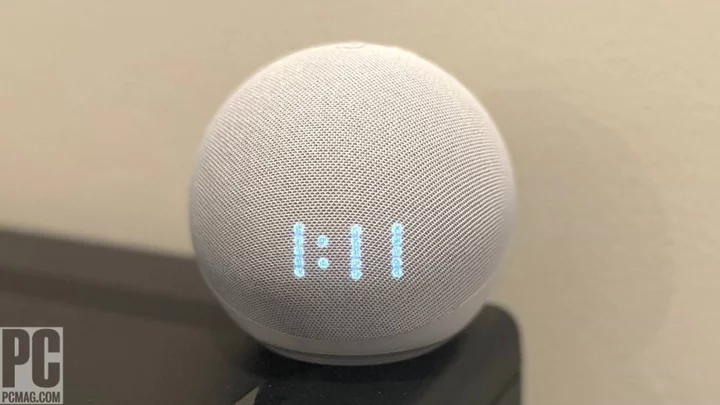Editors' Note: This is the most recent version of the Amazon Echo Dot With Clock. Read our original review from October 20, 2022 below.
Amazon tends to push its Echo smart speakers forward with small steps more often than big ones, and sometimes small steps are just enough. The fifth-generation Echo Dot With Clock ($59.99) doesn’t sound much different from the previous version, but its revised LED display is far more useful with more to show than just the time, and new motion sensors let you interact with the speaker with a tap. Considering the Echo Dot series has been a favorite of ours for generations, it’s little surprise that the 2022 iteration of the Echo Dot With Clock earns our Editors’ Choice award.
Same Sphere, Better Display
The fifth-generation Echo Dot With Clock looks almost physically identical to the fourth-generation model. It’s a slightly squat 3.9-by-3.5-inch sphere (HD) available in light blue or white. The sphere is split diagonally, with the top and forward half covered in grille fabric and the bottom and back half bound in matte plastic. Four rubber buttons (action, mic mute, and volume up and down) protrude from the fabric along the top of the sphere. A light ring runs around the flat base; it glows blue when you interact with Alexa and will focus a particularly bright point to indicate the direction from which it registered the command.
The clock part of the speaker is hidden behind the fabric grille when it isn’t active. It's a rectangular, 5-by-24 array of white LEDs. This fifth-gen model expands the functionality of the LEDs with scrolling alphanumeric strings and simple symbols. By default it shows the time in digital clock format and any timers, just like the previous model. New support for scrolling numbers and symbols allows the Echo Dot With Clock to show the current weather, current song title and artist, and other information. It isn’t nearly as powerful as the screen of a smart display, but it’s much more useful than the numbers-only LEDs on the previous model.
Interior Renovations
In addition to the obvious exterior LED update, Amazon has upgraded the internal speaker driver. It’s slightly larger, measuring 1.73 inches across compared with the 1.6-inch driver of the fourth-generation Echo Dot. Despite the larger membrane, the newer speaker is an ounce and a half lighter at 10.7 ounces. Since this isn’t a portable speaker and is designed to be stationary, that weight reduction doesn’t make much of a difference in everyday use.
New motion sensors in the Echo Dot With Clock lead to additional ways of interacting with the speaker beyond using your voice and the few physical buttons on top. Now you can lightly tap the top of the speaker to play or pause songs, end calls, stop ringing timers, or snooze alarms.
Amazon has also added eero mesh network support so the Echo Dot can serve as a node for your eero network if you use one. Amazon says the node allows for up to 1,000 square feet of eero Wi-Fi coverage, with speeds up to 100Mbps for up to 10 devices at a time. The Echo Dot With Clock also supports Bluetooth and dual-band 802.11ac Wi-Fi, and can work with the Amazon Sidewalk shared network (though we recommend not enabling this during setup due to privacy and security concerns).
Unfortunately, Amazon cut a critical feature of the previous Echo Dot: a 3.5mm jack. This means the new Echo Dot With Clock cannot be connected to a larger speaker.
The Power of Alexa
As an Echo speaker, the Echo Dot With Clock is designed to use Amazon’s Alexa voice assistant. Alexa is eight years old now—almost a tween!—and Amazon has ceaselessly pushed a steady stream of updates to its assistant to give it more functionality. It’s a powerful voice assistant that lets you seek out sports scores, weather reports, and other useful information; set alarms and timers; search for and play music and audiobooks; control smart home devices; and make voice calls.
For entertainment, Alexa can sift through music on Amazon Music and page through audiobooks on Audible. It can also access Amp, Apple Music, Apple Podcasts, Deezer, iHeartRadio, Pandora, Saavn, SiriusXM, Spotify, Tidal, and TuneIn to play music, podcasts, and radio stations via those services. If you pair the Echo Dot with an Amazon Fire TV Stick, Fire TV Cube, or Fire TV, you can control that streaming device and various video services through Alexa, too.
Alexa is one of the most widely supported voice assistants for controlling smart home devices. Thousands are supported across all major consumer home automation brands, and include video doorbells, security cameras, smart bulbs, smart locks, smart plugs, and smart thermostats. You can set up routines to control multiple devices with a single voice command or when certain circumstances are met, such as the time of day. Alexa can develop Hunches, wherein it evaluates the state of smart home devices based on your past behavior and prompts you to do things like lock the doors or turn off the lights when you’re away from home.
Alexa supports making voice calls through a variety of services. You can call any standard (non-toll-free, premium-rate, or emergency) number in the United States, Canada, Mexico, and the United Kingdom, and receive calls by linking your AT&T or Verizon phone account. You can talk to other Amazon users through Drop In, which lets you directly speak to your Amazon contacts through their Alexa devices (or the Alexa app on their phone). Alexa also supports Skype calls through the Echo Dot With Clock.
Most of these features are comparable with those available to Google Assistant and Google's Nest line of smart devices. Whether you choose to be an Amazon household or a Google household is a personal one. Historically, Google Assistant is better at natural speech recognition while Alexa supports more third-party skills. At a base feature level, however, they are more or less equal.
Balanced, But Not Booming Audio
Despite the larger speaker driver, don’t expect a lot more power from the fifth-gen Echo Dot With Clock. Our bass test track, The Knife’s “Silent Shout,” sounds weak on the speaker, with little low-frequency response. It also distorts at higher volume levels. “Silent Shout” is a particularly punishing sub-bass-heavy song, though, and the Echo Dot With Clock sounds significantly better with other music.
The opening acoustic guitar plucks in Yes’ “Roundabout” sound full and get plenty of low-mid resonance combined with a bit of high-mid clarity to bring out some string texture even if it isn’t very crisp. When the track fully kicks in, the bassline, drums, guitar strums, and vocals all share attention fairly evenly. The bassline doesn’t have much low-frequency presence and sounds a bit poppy, and the cymbals and guitar don’t have enough high-frequency response to really cut through the mix, but within the small speaker’s modest frequency range it sounds full and nicely balanced.
The riffs and vocals in The Crystal Method’s “Burn Too Slow” get plenty of high-mid attention, though again the fairly limited range of the speaker is apparent. The backbeat gets some low-mid power, but it isn’t the deep, ominous thump the track should have. Similarly, the voice and riffs, while prominent, don’t have a lot of high-frequency edge.
These complaints are to be expected for a tiny $60 smart speaker. A small, single driver just can’t deliver the kind of frequency range that a larger speaker with multiple drivers (like the much larger $199.99 Amazon Echo Studio) can. Ultimately, the Echo Dot With Clock provides a balanced, if limited, sound that can capably fill a small room.
A More Useful Dot
The fifth-generation Amazon Echo Dot With Clock is a notable upgrade over the previous version thanks to its more useful display and convenient tap gestures. It doesn’t sound much better as a speaker, but for $60, it isn’t designed to be the main speaker for most rooms. That said, it sounds better than the $49 Google Nest Mini, and the LED readout is easily worth the $10 premium over the Nest Mini or the standard Echo Dot, earning the Echo Dot With Clock our Editors' Choice award. If you want a smart speaker with more power and superior audio, the larger Amazon Echo and Google Nest Audio are both excellent picks at around twice the price, while the Echo Studio is even more impressive, with room-filling spatial audio for $199.99.









